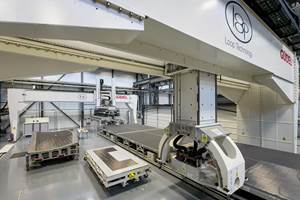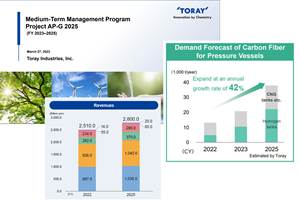Swinburne University and CSIRO's Industry 4.0 Testlab for Composite Additive Manufacturing
Australia and Germany collaborate to build Composites 4.0 production line for competitive advantage in next-gen manufacturing and workforce.
Swinburne University of Technology (Melbourne, Australia) is establishing an Industry 4.0 Testlab for Composite Additive Manufacturing in partnership with Australia’s National Science Agency, the Commonwealth Scientific and Industrial Research Organisation (CSIRO, see “Developing higher-quality, higher-strength, lower-cost carbon fibers”). The facility is currently under construction at CSIRO’s Clayton site and will be completed in October 2020.
Supported by the Australian Federal Government, this Industry 4.0 Testlab for Composites is one of six in an Australian national network, similar to the Labs Network Industrie 4.0 in Germany. This Testlab is the first national facility in the state based network where the goal is to enable small and medium enterprises (SMEs) to test new technologies and business models created by Industry 4.0, exploring aspects from design to economic feasibility, in a pre-competitive environment with minimal technical and financial risk. Each Testlab has a distinctive product focus. For Swinburne, this is additive manufacturing of composites.
“The Industry 4.0 Testlab for Composites at Swinburne will provide a pilot-scale process to advance Australia’s manufacturing capabilities,” says Bronwyn Fox, deputy vice chancellor of research and enterprise at Swinburne University. Fox joined Swinburne in 2015, initially taking on the role of Factory of the Future director and then director of the university’s Manufacturing Futures Research Institute. Before joining Swinburne, she was research director for Carbon Nexus at Deakin University.
“Swinburne’s Testlab will demonstrate the features of digital composites production in an immersive environment,” says Fox. “The pilot-scale processes will be digitally controlled from part design and optimization through to the finished product. We will also create a digital twin of the process and push the boundaries of virtual commissioning.”
This composites 4.0 hub will be housed in a new, bespoke building. “The joint CSIRO/Swinburne Testlab is focused on a world-first process for additive manufacturing of carbon fiber-reinforced composites at an industrial scale,” says Dr. Marcus Zipper, executive director of CSIRO’s Future Industries division. “This makes its location, at the heart of Clayton’s additive manufacturing precinct, a great fit. At CSIRO we’re all about creating opportunities for SMEs and the broader innovation ecosystem, and this Testlab is another example of that.”
Partners and process
There are many key partners in the Industry 4.0 Testlab for Composites, with Siemens Australia (Bayswater, Victoria) being one of the first, extending a $135 million digitalization software grant to Swinburne in 2017. This provides the Composites 4.0 Testlab with a suite of advanced product lifecycle management (PLM) software as well as the Siemens cloud-based, open Internet of Things (IoT) platform, MindSphere.
According to a Siemens Australia presentation, as of August 2019, there were roughly 500 digital apps/offerings within MindSphere and 1.4 million connected devices and systems. “MindSphere will enable equipment from a wide range of manufacturers to communicate with each other,” Fox explains in her ICCM22 presentation, "An Industry 4.0 Approach to the 3D Printing of Composite Materials". This paper describes how the Swinburne Industry 4.0 Testlab will function:
“Sensors … will enable each stage of the production line to collect a large amount of process data. This information will be stored in a secure local cloud and will also be used immediately to feedforward and feedback production data to other machines in the line, thereby enabling a self-adapting production process.
The proposed line ... is designed to allow product inspection after each stage of the manufacturing process. The inspection data will also be stored in the local cloud. Analysis of the large datasets stored in the cloud may lead to the discovery of new and unexpected correlations between the state of the finished product and the parameters of different stages of the manufacturing process, which in turn may be utilized to optimize the product.”
Pilot-scale production line for Swinburne University’s Industry 4.0 Testlab for Composite Additive Manufacturing. SOURCE | Swinburne University
Fox also points out that Industry 4.0 composite manufacturing lines cannot be bought off-the shelf. Thus, Swinburne developed a network of suppliers and end users to inform the design and development of its Composites 4.0 Testlab equipment and facility. Partners supplying key components include:
FILL (Gurten, Austria) has supplied the Multilayer system, which stacks precisely cut and oriented, unidirectional fiber tapes into near net-shapes up to 1.6 by 1.6 meters in size. Near net-shapes using tape reduce scrap from more than 60% to less than 10%. The tapes are deposited from spools onto a rotating table, with a layer completed every 15 seconds. Fox notes that Fill’s Multilayer machine can lay up tapes of thermoset prepreg and towpreg, as well as dry fiber and low-melt thermoplastic, such as polyamide (PA). There is ongoing R&D for high-melt thermoplastics such as polyetheretherketone (PEEK) and polyetherketoneketone (PEKK). “The Multilayer machine also enables hybrid materials, such as mixing glass and carbon fibers and blends with natural fibers, etc.,” she adds.
Quickstep (Sydney, Australia) is the largest independent aerospace-grade, advanced composite manufacturer in Australia, offering extensive expertise in both autoclave-cured and out of autoclave (OOA) composites. Quickstep’s patented OOA system, Qure, and its high-performance version for aerospace applications, AeroQure, is an advanced composites manufacturing process that offers significant advantages over traditional manufacturing techniques such as autoclave curing, including:
- Low capital cost for set-up
- Significantly shorter cure cycle times
- Reduced energy consumption
- Design flexibility to meet or improve material properties of the end product
- Ability to produce complex integrated parts.
Qure uses a pressurized circulating heat transfer fluid (HTF) to support the mold and rapidly heat and cool the part. Lower pressure processing (vacuum plus up to 2.5 bar) facilitates lower cost tooling. Rapid heating of the mold and material reduces the process viscosity, improving air release and fiber wetting. Lower viscosity improves adhesion to honeycomb and foam cores, resulting in higher peel strength and reduced core crush in curing. The HTF allows superior thermal control, even for thick laminates prone to exothermic reactions.
The Qure process uses a pressurized circulating heat transfer fluid (HTF) to support the mold and rapidly heat and cool the part. Source | Quickstep
Langzauner (Lambrechten, Austria) is supplying a high-temperature, automated press, with up to 300 tons of clamping force that is multi-process capable — from variations of resin transfer molding (RTM) to thermoforming. It will enable injection of resin into dry preforms, followed by cure, or compression molding of thermoset and thermoplastic prepregs.
The press achieves energy efficiency/savings via servo hydraulics and the highest accuracy, even at asymmetric loading, through a single piston control. A high-performing infrared (IR) oven quickly heats materials to the desired processing temperature, compensating for different thicknesses using an individual radiator control system. Quick transfer of the preheated material to the pressing station is ensured by a linear axis. The high-temperature platen heating system can mold parts at temperatures to at least 400°C, accommodating processing of advanced thermoplastics such as polyetheretherketone (PEEK).
The press is also double-diaphragm frame capable (see 2020 blog on double-diaphragm forming). The highest degree of digitization and monitoring is guaranteed by a flexible, robust, and user-friendly software.
NETZSCH (Selb, Germany) will provide in-mold cure monitoring technology, enabling control of composite manufacturing based on material behavior.
Plataine (Israel) offers digitization, optimization and digital twin software for composites manufacturing that enables tracking of tools, parts and raw materials, creation of digital twins and analysis of machine sensor data to optimize part production. Plataine has a wide range of partnerships with composites industry leaders and suppliers, including Siemens.
CIKONI (Stuttgart, Germany) has supplied the DrapeWatch system for inline inspection and digitization of both preforms and consolidated parts. This robot-based 3D analysis system can identify gaps, misalignments and irregularities. It combines a visual sensor for detailed surface inspection with an EddyCurrent sensor for internal defects and in-depth material analysis. Data is analyzed by the system’s artificial intelligence algorithms to provide early detection of defects, avoiding costly reruns. An interface to finite element analysis (FEA) enables export of fiber angle results to simulation models for evaluation of defects’ impact on part performance. The modular system can also be extended by integrating thermography, ultrasonic or laser scanning devices.
The equipment from Fill and Langzauner will be installed mid-2020. “Fill has been doing experiments for us,” notes Fox, “and we have sent personnel to Austria for training on particular parts as well as training in digitization. Once all of the process equipment is commissioned, we will use Plataine’s RFID (radio frequency identification) technology and scale into its latest edge computing platform, PlataineEdge, which will enable real-time analysis and communication between machines.”
Another part of the vision for Swinburne’s Composites 4.0 Testlab is to enable flexible manufacturing that can adapt to changing industry demands very rapidly:
“In a typical production line, a product change or modification requires significant equipment modifications and manual interventions. Hence, for such a product change to be profitable, a minimum batch size of the new product is required. In contrast, in the Industry 4.0 vision, smart factories allow individual customer requirements and even one-off items to be manufactured profitably. Such a factory can easily respond to last-minute changes on behalf of the customers and suppliers. Consequently, one of the main objectives of the proposed manufacturing line is to enable it to produce different products with minimal or no manual intervention.” — Fox and Subic, "An Industry 4.0 Approach to the 3D Printing of Composite Materials"
ARENA2036 and links to global value chains
In addition to providing a digitized physical composites 4.0 factory, Swinburne will also train the next-generation workforce. The latter is made possible through a $1 million/four-year grant from Australia’s Global Innovation Linkages Program. A key partner in this initiative is ARENA2036, the University of Stuttgart’s industry-driven, on-campus R&D program, self-described as “The highly flexible research platform for mobility and production of the future”. Supported by the Federal Ministry of Education and Research (BMBF, Bonn, Germany) and run as a registered association with 38 members from science and industry, ARENA2036 features a “STARTUP AUTOBAHN” and a 10,000-square meter building, 4,700 square meters of which is an open production hall with a 16-meter high ceiling and 10-ton industrial crane. Swinburne joined ARENA2036 as a member in 2018.
A key partner in Swinburne’s Industry 4.0 Testlab for composites, ARENA2036 features a 4,700-square meter open production hall with a 16-meter high ceiling and 10-ton industrial crane. Swinburne joined its roster of 38 members in 2018. SOURCE | ARENA2036
Swinburne’s Composites 4.0 Testlab and ARENA2036 are collaborating via a $3.6 million program supported by the Australian Government’s Global Innovation Linkage (GIL) scheme on Industry 4.0 manufacturing of high-volume, lightweight composites with a focus on a specific production technology enabled by flexible tooling systems and digital twin technology. It will include:
- R&D and commercialization, facilitating joint start-ups.
- Joint recruitment, co-supervision and exchange of PhD students
- Joint research workshops and symposiums.
This partnership also envisions joint R&D projects with Fraunhofer Institute for Manufacturing Engineering and Automation and the Institute for Industrial Engineering (Fraunhofer IPA and IAO, Stuttgart), including PhD student internships at the Institute for Aircraft Design (IFB) at the University of Stuttgart in relevant Industry 4.0 areas. “The GIL project is an important milestone for advanced composite processes and also for the collaboration of SUT, University of Stuttgart and ARENA2036,” says professor Peter Middendorf, director of the IFB. “We are proud to be a partner in the project itself and to announce two other collaborative research projects supported by the German Government that are directly linked to GIL.”
“We will train a new cohort of digitally savvy joint PhD students between Swinburne and the University of Stuttgart,” says Fox. “We will not only further develop Composite 4.0 processes, but also cement global partnerships and create new products that can be exported from Australia, particularly in new mobility markets. Through these international collaborations, Swinburne’s Industry 4.0 Testlab will actively link Australian SMEs into global value chains. We’ve already demonstrated this with our partner Imagine Intelligent Materials and we look forward to extending this to further Australian innovators.”
“International competition will be fierce in the rapidly approaching digital manufacturing of the future,” says Fox. “That’s why our development of this composites 4.0 capability and workforce is so important now.”
The Industry 4.0 Testlab for Composite Additive Manufacturing at Swinburne University will be launched in December 2020. Stay tuned to CW for future updates and read our July 2020 feature, “Composites 4.0: Digital transformation, adaptive production, new paradigms” along with its five online sidebars:
Related Content
Clemson Composites Center leads research in low-cost composite tooling
Innovative technology approach to use additive manufacturing and artificial intelligence to produce tools faster, at a lower cost and with less environmental impact.
Read MoreUltra high-rate composite deposition system trials to surpass layup targets
The NCC, alongside partners Loop Technology, Coriolis and Güdel, are on track to deliver dry fiber deposition rates exceeding 350 kilograms/hour, seven times more than standard aerospace rates.
Read MoreBoeing reveals new Advanced Composite Fabrication Center
First of new purpose-built innovative defense factories based in Mesa, Ariz., U.S., will produce advanced composite components, leverage Industry 4.0 best practices from recent programs.
Read MoreToray announces growth, investment in carbon fiber composite materials
As part of its 2023-2025 management strategy, Toray projects 42% growth for pressure vessels, 30% growth in carbon fiber composite materials revenue and a doubling of capital investment.
Read MoreRead Next
CW’s 2024 Top Shops survey offers new approach to benchmarking
Respondents that complete the survey by April 30, 2024, have the chance to be recognized as an honoree.
Read MoreFrom the CW Archives: The tale of the thermoplastic cryotank
In 2006, guest columnist Bob Hartunian related the story of his efforts two decades prior, while at McDonnell Douglas, to develop a thermoplastic composite crytank for hydrogen storage. He learned a lot of lessons.
Read MoreComposites end markets: Energy (2024)
Composites are used widely in oil/gas, wind and other renewable energy applications. Despite market challenges, growth potential and innovation for composites continue.
Read More




























.jpg;maxWidth=300;quality=90)







